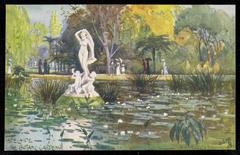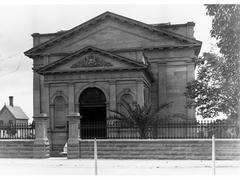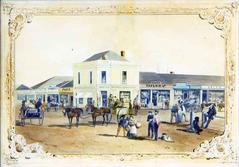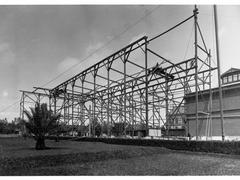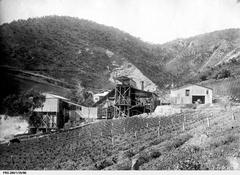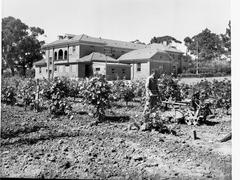
Old Gum Tree Adelaide: Visiting Hours, Tickets, and Historical Significance Guide
Date: 04/07/2025
Introduction
The Old Gum Tree in Glenelg North, Adelaide, is a powerful symbol of South Australia’s colonial foundation and an enduring landmark of both European settlement and Indigenous heritage. This historic site, where Governor John Hindmarsh declared the establishment of South Australia on December 28, 1836, offers visitors a unique opportunity to connect with the state’s origins, participate in community traditions, and reflect on the ongoing journey toward reconciliation. Whether you are a history enthusiast, a family seeking a meaningful outing, or a tourist exploring Adelaide’s heritage, the Old Gum Tree Reserve provides educational resources, inclusive amenities, and engaging events for all.
For the most current information, updates, and interactive resources, consult official channels and heritage organizations (National Today; City of Holdfast Bay; Atlas Obscura).
Table of Contents
- Historical Background and Heritage Preservation
- Visiting the Old Gum Tree: Hours, Admission, and Accessibility
- Community Traditions and Cultural Significance
- Responsible Tourism and Indigenous Perspectives
- Visitor Experience and Practical Tips
- Frequently Asked Questions (FAQ)
- Conclusion and Call to Action
- References and Further Reading
Historical Background and Heritage Preservation
The Proclamation of South Australia
On December 28, 1836, under the distinctive arched form of the Old Gum Tree, Captain John Hindmarsh, the first Governor of South Australia, read the proclamation that established the colony. This act marked the introduction of British law and governance, shaping the future of the region. The event was witnessed by settlers and the local Kaurna people, whose traditional connection to the land remains vital (National Today; Atlas Obscura; ABC News).
The Role and Preservation of the Old Gum Tree
Although the original red gum (Eucalyptus camaldulensis) died in 1907, its remains have been preserved in concrete since 1963 to safeguard its shape and historical importance. The site was recognized as a memorial in the mid-19th century and officially added to the South Australian Heritage Register in 1980. Interpretive plaques, commemorative panels, and landscaping evoke the environment of the 1830s, ensuring ongoing public education and engagement (Monument Australia; City of Holdfast Bay).
Visiting the Old Gum Tree: Hours, Admission, and Accessibility
Location and Setting
The Old Gum Tree Reserve is situated at 1 Old Gum Tree Drive, Glenelg North, about 11 kilometers southwest of Adelaide’s city center. It is easily accessed via car, public transport (including the Glenelg tram line), or on foot from Glenelg’s beach and shopping precincts (The Fold).
Visiting Hours and Admission
- Hours: Open daily from dawn to dusk (typically 8:00 AM – 6:00 PM).
- Admission: Free entry. No tickets or bookings are required for general access.
Accessibility
The reserve is designed to be inclusive and accommodating:
- Wheelchair and Pram Access: Level, paved pathways throughout the site.
- Accessible Amenities: Toilets, picnic areas, seating, and designated parking spaces.
- Family-Friendly Facilities: Fully fenced playground with accessible play equipment, BBQs, and shaded rest areas (Kids in Adelaide).
Community Traditions and Cultural Significance
Proclamation Day: Annual Ceremonies
Each year on December 28, the Old Gum Tree is the focus of Proclamation Day celebrations. The event features a ceremonial reading of the original proclamation by the current Governor, historical reenactments, live music, and family activities. This tradition connects the present to South Australia’s foundational moment and fosters community spirit (Public Holidays Australia; Trek Zone).
Symbol of Identity and Progress
South Australia is unique among Australian states, having been established by free settlers rather than as a penal colony. The Old Gum Tree thus stands as a symbol of civic participation, progress, and the region’s evolving identity.
Responsible Tourism and Indigenous Perspectives
Acknowledging the Kaurna People
Glenelg, or Pathawilyangga, lies within the traditional lands of the Kaurna people. The reserve’s interpretive materials and nearby museums, such as the Bay Discovery Centre, encourage visitors to learn about and honor Indigenous history and ongoing stewardship of the land (The Fold; ABC News).
Visitor Conduct
- Stick to designated paths and avoid climbing or touching the preserved tree.
- Dispose of litter responsibly and respect the site’s flora and fauna.
- Participate respectfully in official events, especially during ceremonies.
Visitor Experience and Practical Tips
Amenities and Comfort
- Picnic & BBQ: Multiple tables, undercover picnic areas, and BBQs available.
- Playground: Fully fenced, inclusive play equipment for all ages and abilities.
- Toilets: Accessible and regularly maintained.
- Parking: Free street parking and accessible spaces on McFarlane Street.
Travel Tips
- Best Times to Visit: Early morning or late afternoon for fewer crowds and better light for photography.
- Public Transport: The Glenelg tram line and local buses provide easy access from Adelaide city.
- Nearby Attractions: Glenelg Beach, Jetty Road shopping precinct, Bay Discovery Centre, and other heritage sites (Secret Attractions).
Educational Value
Interpretive signage and community programs provide context on both European settlement and Indigenous perspectives. School visits, heritage walks, and volunteer projects promote ongoing learning and stewardship.
Frequently Asked Questions (FAQ)
Q: What are the Old Gum Tree visiting hours?
A: The reserve is open daily from dawn to dusk (usually 8:00 AM to 6:00 PM).
Q: Is there an entry fee or ticket required?
A: No, entry is free and open to all.
Q: Are guided tours available?
A: Guided tours are offered during special events, such as Proclamation Day. For group tours or educational visits, contact the City of Holdfast Bay.
Q: Is the site accessible for wheelchairs and strollers?
A: Yes, the reserve features level, paved paths and accessible amenities.
Q: Can I bring children?
A: Absolutely. The playground and open lawns make it a family-friendly destination.
Q: How do I get there by public transport?
A: Take the Glenelg tram from Adelaide city center or local buses to Glenelg North.
Conclusion and Call to Action
The Old Gum Tree Reserve is a cornerstone of South Australian heritage, offering a unique blend of historical significance, community engagement, and inclusive public space. By respecting both colonial and Indigenous histories, visitors can enjoy a meaningful experience and contribute to the preservation of this landmark for future generations.
Plan your visit today and explore more of Adelaide’s historical and cultural sites. For updated information, self-guided tours, or special event details, download the Audiala app and follow our social media channels.
Visuals and Media
Alt text: The Old Gum Tree monument surrounded by mature gum trees in Glenelg North, Adelaide. Alt text: Children playing on accessible flying fox and swings at The Old Gum Tree Reserve playground. Alt text: Map indicating The Old Gum Tree Reserve location near McFarlane Street and Tapley’s Hill Road in Glenelg North.
References and Further Reading
- National Today: Proclamation Day
- Atlas Obscura: Old Gum Tree Reserve
- ABC News: Why is a concrete-filled bent old gum tree significant in SA?
- Monument Australia: Old Gum Tree
- City of Holdfast Bay: Our History
- Secret Attractions: Adelaide Hidden Historical Sites
- Public Holidays Australia: Proclamation Day
- Wikipedia: The Old Gum Tree
- Kids in Adelaide: Old Gum Tree Playground
- The Fold: Old Gum Tree Reserve
- Trek Zone: The Old Gum Tree Adelaide
- Secret Adelaide: Things to do July Adelaide











